-
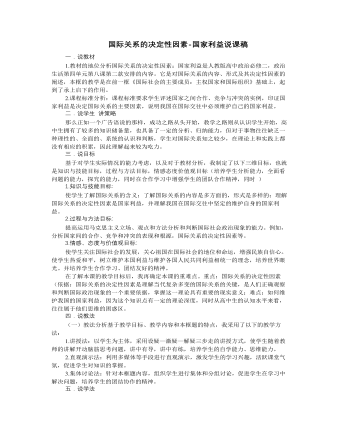
人教版高中政治必修2国际关系的决定性因素-国家利益说课稿
环节四 课堂小结 巩固知识本节课我采用线索性的板书,整个知识结构一目了然,为了充分发挥学生在课堂的主体地位,我将课堂小结交由学生完成,请学生根据课堂学习的内容,结合我的板书设计来进行小结,以此来帮助教师在第一时间掌握学生学习信息的反馈,同时培养学生归纳分析能力、概括能力。环节五 情景回归,情感升华我的实习指导老师告诉过我们,政治这一门学科要从生活中来到生活去,所以在课堂的最后以中菲黄岩岛事件为材料背景,引导同学们思考:作为一名爱国青年请就如何解决这一问题向政府提出自己的建议和意见。以此培养学生对理论的实际运用能力,同时检验他们对知识的真正掌握情况,以此达到情感的升华,本节课,我根据建构主义理论,强调学生是学习的中心,学生是知识意义的主动建构者,是信息加工的主体,要强调学生在课堂中的参与性、以及探究性,不仅让他们懂得知识,更让他们相信知识,并且将知识融入到实践当中去,最终达到知、情、意、行的统一。
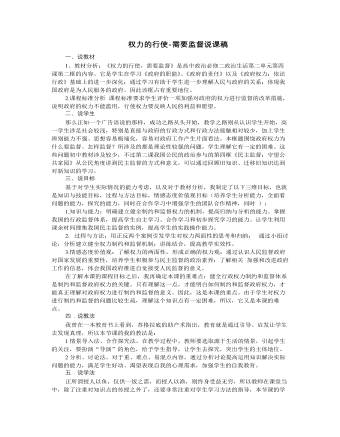
人教版高中政治必修2权力的行使-需要监督说课稿
环节四 情景回归 参与体验(教学内容:为政务公开喝彩)探究问题:什么是政务公开,目的何在,有何意义?我将引导学生,想想我省的政务公开开展的如何呢?怎样才能了解到这些内容呢?这样,通过联系本省的在增强政府工作透明度方面的做法,在进行知识教育的同时,拉近了学生与政治生活的距离,增强了学生参与民主监督的意识和能力。同时也可以把其他相关的网站如市政府门户网站介绍给大家,我国各级政府建立了信息公开制度和办事公开制度;然后,我将让学生们思考实施政务公开有什么意义?对于其意义同样是让学生根据其特点进行概括,达到方法的训练和能力的提升。环节五 课堂小结 巩固知识本节课我采用线索性的板书,整个知识结构一目了然,为了充分发挥学生在课堂的主体地位,我将课堂小结交由学生完成,请学生根据课堂学习的内容,结合我的板书设计来进行小结,以此来帮助教师在第一时间掌握学生学习信息的反馈,同时培养学生归纳分析能力、概括能力。
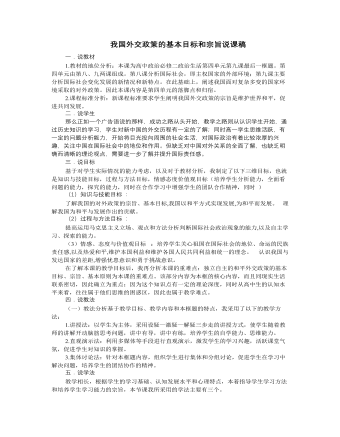
人教版高中政治必修2我国外交政策的基本目标和宗旨说课稿
环节四 课堂小结 巩固知识本节课我采用线索性的板书,整个知识结构一目了然,为了充分发挥学生在课堂的主体地位,我将课堂小结交由学生完成,请学生根据课堂学习的内容,结合我的板书设计来进行小结,以此来帮助教师在第一时间掌握学生学习信息的反馈,同时培养学生归纳分析能力、概括能力。环节五 情景回归,情感升华我的实习指导老师告诉过我们,政治这一门学科要从生活中来到生活去,所以在课堂的最后布置课外作业,以此培养学生对理论的实际运用能力,同时检验他们对知识的真正掌握情况,以此达到情感的升华,本节课,我根据建构主义理论,强调学生是学习的中心,学生是知识意义的主动建构者,是信息加工的主体,要强调学生在课堂中的参与性、以及探究性,不仅让他们懂得知识,更让他们相信知识,并且将知识融入到实践当中去,最终达到知、情、意、行的统一。

人教版高中语文必修1《记梁任公先生的一次演讲》说课稿2篇
6、思考:作者心目中的梁启超是什么形象呢?明确:梁任公是位有学问,有文采,有热心肠的学者。由学生找出文中体现梁启超学问、文采的句子。教师展示幻灯。补充介绍:文采不仅体现在书面,也能从流畅的口语表达中反映。《箜篌引》短短十六字蕴涵了什么故事,竟让梁启超描述得生动感人以至作者多年后还印象深刻呢?《箜篌引》出自《汉乐府诗》,记叙了一个悲惨壮烈的故事:朝鲜水兵在水边撑船巡逻时,见一个白发狂夫提壶渡江,被水冲走。他的妻子劝阻不及,悲痛欲绝,取出箜篌对着江水反复吟唱。一曲终了,她也投河随夫而去。朝鲜水兵回家向自己的妻子丽玉讲述了这个故事,丽玉援引故事中的悲情,创作了这首歌曲,听过的人无不动容。7、朗读训练了解《箜篌引》的故事后,请各小组选派代表朗读,由学生点评,体会梁启超演讲技巧的高超。8、文中说梁任公是个热心肠的人,你同意吗?通过结尾段的“热心肠”转入对其人格的分析。
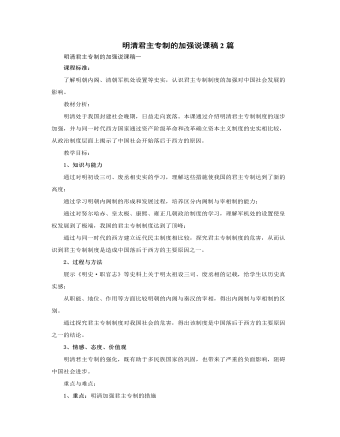
人教版高中历史必修1明清君主专制的加强说课稿2篇
四、说教法应该充分利用历史学科蕴含丰富图片、史料资料的特点,采用多媒体教学手段,创设含有真实事件或真实问题的情境,让学生在探究事件或解决问题的过程中,自主地理解知识,使教学过程成为一个动态的、有机的整体。使学习过程成为“感知-理解-运用”的过程,更是掌握方法、积累经验、发展能力、生成情感的过程。五、说教学过程1.新课导入带领同学们回顾一下第2、3课学习的内容,因为讲的是专制主义中央集权的建立,讲的是专制主义中央集权的发展,对这两节课内容的复习将专制主义中央集权的发发展脉络完整的呈现在学生面前。接下来就通过对胡惟庸案的讲解导入本节课的内容。2.问题探究,突破重点、难点导入新课后,通过多媒体课件给学生们展示一段朱元璋大肆杀戮功臣的资料,提示学生大肆杀戮功臣是朱元璋加强中央集权的措施之一,接着引导学生看课本提问他们朱元璋为了加强中央集权还采取了哪些措施,从而得出明代加强中央集权的措施。

人教版高中历史必修3建国以来的重大科技成就说课稿2篇
说教材(一)、本课在教材中的地位:教材在第3单元介绍了古代中国科技的辉煌。第四单元介绍世界近代科技成就,本课主要介绍了现代中国的科技成就。通过对本课的学习,有利于学生感受中国科技古代辉煌、近代落后、现代又取得很大成就这一重要历程,因此本课在教材中具有重要作用。(二)教学内容分析和课标要求:本课主要介绍新中国成立以来我国科学技术成就及作用。从核研究、航空技术、农业新品种研究、计算机应用、生物技术五方面介绍了新中国成立以来取得的举世瞩目的成就。课标对这部分知识作了如下的要求:列举新中国成立以来科技发展的主要成绩,认识科技进步在现代化建设中的重大作用。根据以上对教材内容的分析和课标要求,我将本课的三维目标确定如下:(三)、教学目标1、知识与能力:识记建国后六十多年来所取得的科技成就;理解科学技术是生产力的论断;探究科技的发展在现代化建设中的重要作用。
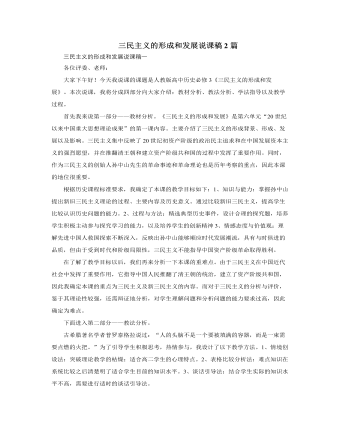
人教版高中历史必修3三民主义的形成和发展说课稿2篇
在学生正确掌握了三民主义的进步性和局限性之后,提出第五个问题:三民主义的局限性是由什么决定的?这一问题学生较易回答,为进入下一目教学打下基础。二、三民主义的实践这目内容在新课导入时已经涉及,故进行略讲,主要采用谈话法,与学生一起回忆、交流。在此基础上,提出探究问题五:在三民主义指导下,孙中山先生进行的一系列革命斗争其结局怎样?为什么会这样?第一问学生较易回答,第二问我组织学生进行交流、讨论。在学生回答的基础上,我将向学生指出:由于三民主义的局限性,它不能指导中国民主革命走向成功,中国革命呼唤新的理论指导。从而过渡到下一目教学。三、旧三民主义发展为新三民主义1、背景:情境再现,激发兴趣分析资料,感悟新知多媒体播放电影《孙中山》片段让学生感受在一系列革命斗争失败后,孙中山先生的彷徨、思索。
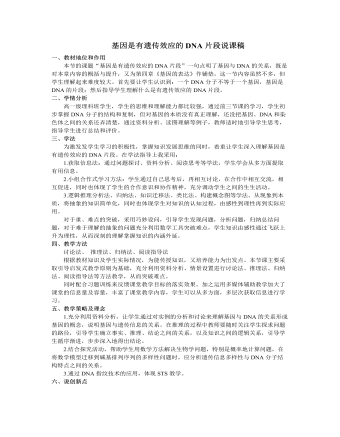
人教版高中生物必修2基因是有遗传效应的DNA片段说课稿
1.基因的化学组成:每个基因含有成百上千个脱氧核苷酸。讲述:基因的脱氧核苷酸排列顺序代表遗传信息。2.基因不同的实质:不同的基因,四种脱氧核苷酸的排列顺序不同,但是每个基因都有特定的排列顺序。3.基因的位置:染色体是基因的主要载体,每个染色体含有一个DNA分子,每个DNA分子含有多个基因,基因在染色体上呈直线排列。4.基因是有遗传效应的DNA片段这就是说,基因是DNA的片段,但必须具有遗传效应(指具有复制、转录、翻译、重组突变及调控等功能)。有的DNA片段属间隔区段,没有控制性状的作用,这样的DNA片段就不是基因。控制某种性状的基因有特定的DNA片段,蕴含特定的遗传信息,可以切除,可以拼接到其他生物的DNA上,从而获得某种性状的表达。例如:把牛的胰岛素基因拼接到大肠杆菌的DNA上,大肠杆菌可以生产胰岛素。
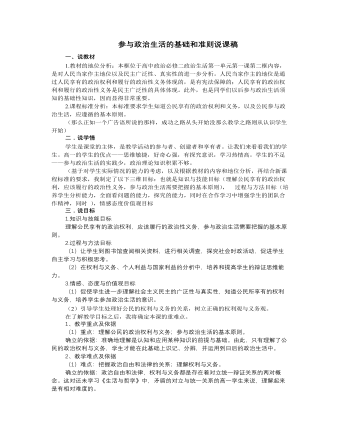
人教版高中政治必修2参与政治生活的基础和准则说课稿
观点一:没有无义务的权利,也没有无权利的义务;观点二权利与义务是完全对等的。根据学生的回答,教师点拨归纳,一般来说,权利与义务是对等的,因为没有义务的权利只能是特权,而没有权利的义务只能是奴役,只有将权利与义务有机结合起来,才能构成一个符合社会发展要求的公民社会,在讨论和思考中,使学生树立正确的观点,引导学生多方面、多角度地辩证认识权利与义务的关系。(3)个人利益和国家利益相结合的原则。引出汶川大地震中一些先进人物事迹,但另外也有一些人发国难财的人,如黑心棉事件等,针对上述材料,请同学们谈谈自己的看法。引导学生理解国家和公民个人利益在根本上是一致的,当个人利益与国家利益发生矛盾时,个人利益要服从国家利益。通过案例分析,培养学生获取信息的能力,自主学习的能力以及全面看问题的能力,再结合教师的讲授,给学生一种茅塞顿开的感觉。
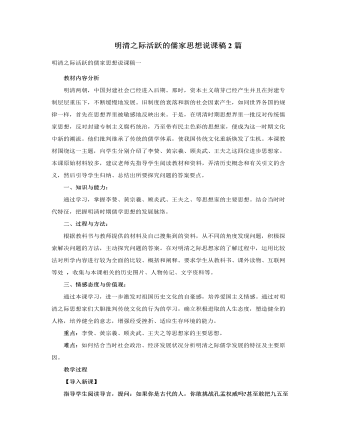
人教版高中历史必修3明清之际活跃的儒家思想说课稿2篇
这是略带提高性的问题,旨在提高学生认识历史的能力,搞清这一历史问题有助于理解中西历史发展的不同。(学生讨论,教师总结归纳并展示。)不是资产阶级民主思想,因为它们是资本主义萌芽的产物,资产阶级作为一个阶级还没有产生。中国民主思想只停留在批判的层次上,并没有提出新的思想,更没有认识到人的基本权利。它没有成为主流思想,因此没有促进明清社会的转型,尚未突破封建思想的束缚。而启蒙思想集中力量批判专制主义、教权主义,描绘了未来资本主义社会的宏伟蓝图,开成了强大的社会思潮,推动了社会向资本主义社会的转变。原因:(1)明清之际的资本主义萌芽较为脆弱,使早期民主思想的产生、发展缺乏强有力的物质基础。(2)中国传统文化的束缚和影响。(3)高度强化的专制中央集权制度的压制使早期民主思想未能形成完整的体系。
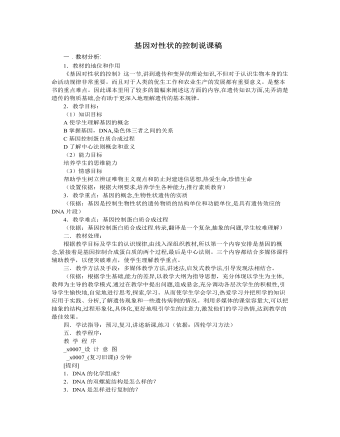
人教版高中生物必修2基因对性状的控制说课稿
7.让学生阅读基因控制蛋白质合成的过程(转录,翻译)13分钟 动画演示“转录,翻译”过程两次,让学生有个整体印象。 培养学生自学习惯,突出教学过程中的学生为主体的教学思想。 8.配合动画引导学生根据预习逐段讲解。 注意问题(1)转录,翻译的地点,模板,生成物不同。因为这是一个极其复杂的过程,避免学生在学习过程中相混肴.(2)这个问题的阐明能为后面“密码子”的概念做好铺垫,避免学生搞不清“遗传密码”和“遗传信息”两个概念。 9.打出板书。 通过动画演示,加深学生的理解和掌握,提高学习效率。 10.重播全过程动画,引导学生讲述。7分钟 _x0007_加深认识,完成从量变到质变的飞跃。 11.过渡:就这样,以DNA为模板合成信使RNA,再以信使RNA为模板,以转运RNA为运载工具,使氨基酸在核糖体中按照一定的顺序排列起来,合成了与亲代一样的蛋白质,从而显现出与亲代同样的性状。从而引出“中心法则”。
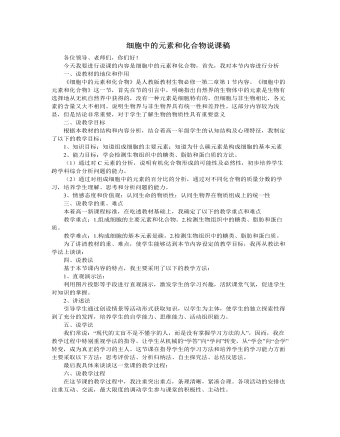
人教版高中生物必修1细胞中的元素和化合物说课稿
一、说教材的地位和作用《细胞中的元素和化合物》是人教版教材生物必修一第二章第1节内容。《细胞中的元素和化合物》这一节,首先在节的引言中,明确指出自然界的生物体中的元素是生物有选择地从无机自然界中获得的,没有一种元素是细胞特有的。但细胞与非生物相比,各元素的含量又大不相同。说明生物界与非生物界具有统一性和差异性。这部分内容较为浅显,但是结论非常重要,对于学生了解生物的物质性具有重要意义二、说教学目标根据本教材的结构和内容分析,结合着高一年级学生的认知结构及心理特征,我制定了以下的教学目标:1、知识目标:知道组成细胞的主要元素;知道为什么碳元素是构成细胞的基本元素2、能力目标:学会检测生物组织中的糖类、脂肪和蛋白质的方法。(1)通过对C元素的分析,说明有机化合物形成的可能性及必然性,初步培养学生跨学科综合分析问题的能力。(2)通过对组成细胞中的元素的百分比的分析,通过对不同化合物的质量分数的学习,培养学生理解、思考和分析问题的能力。

人教版高中生物必修1细胞器—系统内的分工合作说课稿
②与学牛的牛活经验相关,有利激发学列的兴趣。⑧利用多媒体让学牛通过观看、比较、讨论,加深理解f-J利掌握细胞内的牛要细胞器的结构及其功能。④学牛白丰学习,丰动建构新知识。⑤为完成后面的达标图表做充分的准备。4、概括反馈:①设讣达标表格,引导学牛完成。②应用该表格进行小结。③推荐相关网站,以解决课后遇到的附加题。这样设置的理由是①通过完成表格,归纳各种细胞器的结构和功能,使学牛更好的掌握本节课的内容。②培养学牛的分析问题和归纳总结的能力③培养学牛的竞争意识和团队合作精神。④拓展了教育资源,为学牛提供了一个白丰学习的空间。[课堂小结]请4-5位学牛来总结本节课的学刊内容和白己掌握的情况。请教师重新出示“八种细胞器的比较表”和“植物细胞和动物细胞的比较表”对本节内容的知识点、重点、难点进行总结。
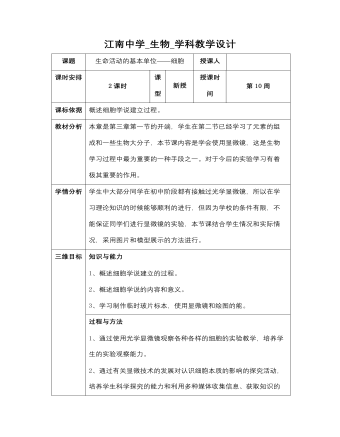
高中生物苏教版必修一《31生命活动及本单位-细胞》教案
本章是第三章第一节的开端,学生在第二节已经学习了元素的组成和一些生物大分子,本节课内容是学会使用显微镜,这是生物学习过程中最为重要的一种手段之一。对于今后的实验学习有着极其重要的作用。 学生中大部分同学在初中阶段都有接触过光学显微镜,所以在学习理论知识的时候能够顺利的进行,但因为学校的条件有限,不能保证同学们进行显微镜的实验,本节课结合学生情况和实际情况,采用图片和模型展示的方法进行。 知识与能力 1、概述细胞学说建立的过程。 2、概述细胞学说的内容和意义。 3、学习制作临时玻片标本,使用显微镜和绘图的能。
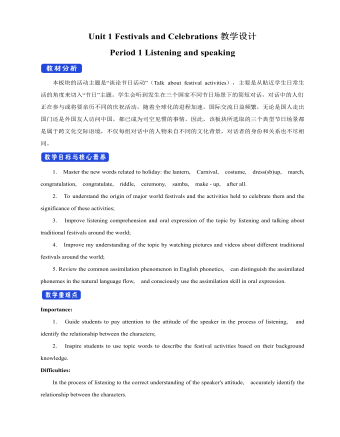
新人教版高中英语必修3Unit 1 Festivals and Celebrations教学设计一
本板块的活动主题是“谈论节日活动”(Talk about festival activities),主要是从贴近学生日常生活的角度来切入“节日”主题。学生会听到发生在三个国家不同节日场景下的简短对话,对话中的人们正在参与或将要亲历不同的庆祝活动。随着全球化的进程加速,国际交流日益频繁,无论是国人走出国门还是外国友人访问中国,都已成为司空见惯的事情。因此,该板块所选取的三个典型节日场景都是属于跨文化交际语境,不仅每组对话中的人物来自不同的文化背景,对话者的身份和关系也不尽相同。1. Master the new words related to holiday: the lantern, Carnival, costume, dress(sb)up, march, congratulation, congratulate, riddle, ceremony, samba, make - up, after all. 2. To understand the origin of major world festivals and the activities held to celebrate them and the significance of these activities;3. Improve listening comprehension and oral expression of the topic by listening and talking about traditional festivals around the world;4. Improve my understanding of the topic by watching pictures and videos about different traditional festivals around the world;5. Review the common assimilation phenomenon in English phonetics, can distinguish the assimilated phonemes in the natural language flow, and consciously use the assimilation skill in oral expression. Importance:1. Guide students to pay attention to the attitude of the speaker in the process of listening, and identify the relationship between the characters;2. Inspire students to use topic words to describe the festival activities based on their background knowledge. Difficulties:In the process of listening to the correct understanding of the speaker's attitude, accurately identify the relationship between the characters.
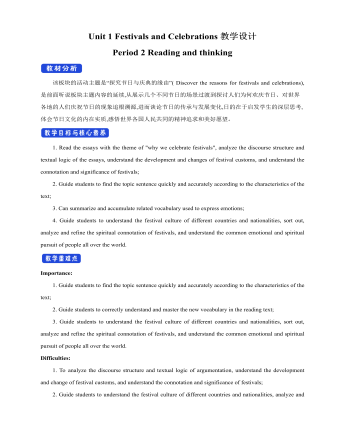
新人教版高中英语必修3Unit 1 Festivals and Celebrations教学设计三
*wide range of origins(= a great number of different origins, many kinds of origins)*It featured a parade and a great feast with music, dancing, and sports. (=A parade and a great feast with music, dancing, and sports were included as important parts of the Egyptian harvest festival.)*.. some traditions may fade away and others may be established.(= Some traditions may disappear gradually, while other new traditions may come into being.)Step 6 Practice(1) Listen and follow the tape.The teacher may remind the students to pay attention to the meaning and usage of the black words in the context, so as to prepare for the completion of the blanks in activity 5 and vocabulary exercises in the exercise book.(2) Students complete the text of activity 5 by themselves.The teacher needs to remind the students to fill in the blanks with the correct form of the vocabulary they have learned in the text.Students exchange their answers with their partners, and then teachers and students check their answers.(3)Finish the Ex in Activity 5 of students’ book.Step 7 Homework1. Read the text again, in-depth understanding of the text;2. Discuss the origin of festivals, the historical changes of related customs, the influence of commercial society on festivals and the connotation and essential meaning of festivals.3. Complete relevant exercises in the guide plan.1、通过本节内容学习,学生是否理解和掌握阅读文本中的新词汇的意义与用法;2、通过本节内容学习,学生能否结合文本特点快速而准确地找到主题句;3、通过本节内容学习,学生能否理清论说文的语篇结构和文本逻辑,了解节日风俗发展与变迁,感悟节日的内涵与意义。

新人教版高中英语必修3Unit 3 Diverse Cultures教学设计三
The price is the same as(the price was)before the war.价格与战前相同。(4)定语从句中的“关系代词+助动词be”可以省略。The ticket(that/which was)booked by his sister has been sent to him.他妹妹订的那张票已送到了他那里。Step 5 PracticeActivity 3(1) Guide students to complete the four activities in the Using Structures part of exercise book, in which activities 1 and 2 focus on ellipsis in dialogue answers, activity 3 focus on signs and headlines, two typical situations where ellipsis is used, and activity 4 focus on ellipsis in diary, an informal style.(2) Combine the examples in the above activities, ask students to summarize the omitted situations in groups, and make their own summary into a poster, and post it on the class wall after class to share with the class.(This step should give full play to the subjectivity of students, and teachers should encourage students to conclude different ellipsis phenomena according to their own understanding, they can conclude according to the different parts omitted in the sentence.)Step 6 Homework1. Understand and master the usages of ellipsis;2. Finish the other exercises in Using structures of Workbook.1、通过本节内容学习,学生是否理解和掌握省略的用法;2、通过本节内容学习,学生能否根据上下文语境或情景恢复句子中省略的成分,体会使用省略的效果;3、通过本节内容学习,学生能否独立完成练习册和导学案中的相关练习。

新人教版高中英语必修3Unit 3 Diverse Cultures教学设计二
(2)Consolidate key vocabulary.Ask the students to complete the exercises of activity 6 by themselves. Then ask them to check the answers with their partners.(The first language:Damage of the 1906 San Francisco earthquake and fire.A second language: Yunnan - one of the most diverse provinces in China).Step 5 Language points1. The teacher asks the students to read the text carefully, find out the more words and long and difficult sentences in the text and draw lines, understand the use of vocabulary, and analyze the structure of long and difficult sentences.2. The teacher explains and summarizes the usage of core vocabulary and asks the students to take notes.3. The teacher analyzes and explains the long and difficult sentences that the students don't understand, so that the students can understand them better.Step 6 Homework1. Read the text again, in-depth understanding of the text;2. Master the use of core vocabulary and understand the long and difficult sentences.3. Complete relevant exercises in the guide plan.1、通过本节内容学习,学生是否理解和掌握阅读文本中的新词汇的意义与用法;2、通过本节内容学习,学生能否结合文本特点了解文章的结构和作者的写作逻辑;3、通过本节内容学习,学生能否了解旧金山的城市风貌、文化特色,以及加利福尼亚州的历史,体会多元文化对美国的影响。

新人教版高中英语必修3Unit 3 Diverse Cultures教学设计四
该板块的活动主题是“介绍一个有显著文化特征的地方”( Describe a place with distinctive cultural identity)。该板块通过介绍中国城继续聚焦中国文化。本单元主题图呈现的是旧金山中国城的典型景象, Reading and Thinking部分也提到中国城,为该板块作铺垫。介绍中国城的目的主要是体现中国文化与美国多元文化的关系,它是美国多元文化的重要组成部分。中国城也是海外华人的精神家园和传播中国文化的重要窗口,外国人在中国城能近距离体验中国文化。1. Read the text to understand the cultural characteristics of Chinatown in San Francisco and the relationship between Chinese culture and American multiculturalism;2. Through reading, learn to comb the main information of the article, understand the author's writing purpose and writing characteristics;3. Learn to give a comprehensive, accurate, and organized description of the city or town you live in;Learn to revise and evaluate your writing.Importance:1. Guide the students to read the introduction of Chinatown in San Francisco and grasp its writing characteristics;2. Guide students to introduce their city or town in a comprehensive, accurate and organized way;3. Learn to comb the main information of the article, understand the author's writing purpose, and master the core vocabulary.
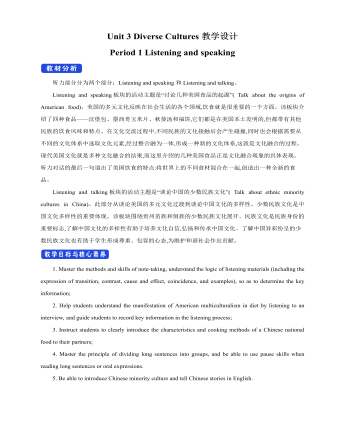
新人教版高中英语必修3Unit 3 Diverse Cultures教学设计一
Activity 81.Grasp the main idea of the listening.Listen to the tape and answer the following questions:Who are the two speakers in the listening? What is their relationship?What is the main idea of the first part of the listening? How about the second part?2.Complete the passage.Ask the students to quickly review the summaries of the two listening materials in activity 2. Then play the recording for the second time.Ask them to complete the passage and fill in the blanks.3.Play the recording again and ask the students to use the structure diagram to comb the information structure in the listening.(While listening, take notes. Capture key information quickly and accurately.)Step 8 Talking Activity 91.Focus on the listening text.Listen to the students and listen to the tape. Let them understand the attitudes of Wu Yue and Justin in the conversation.How does Wu Yue feel about Chinese minority cultures?What does Justin think of the Miao and Dong cultures?How do you know that?2.learn functional items that express concerns.Ask students to focus on the expressions listed in activity. 3.And try to analyze the meaning they convey, including praise (Super!).Agree (Exactly!)"(You're kidding.!)Tell me more about it. Tell me more about it.For example, "Yeah Sure." "Definitely!" "Certainly!" "No kidding!" "No wonder!" and so on.4.Ask the students to have conversations in small groups, acting as Jsim and his friends.Justin shares his travels in Guizhou with friends and his thoughts;Justin's friends should give appropriate feedback, express their interest in relevant information, and ask for information when necessary.In order to enrich the dialogue, teachers can expand and supplement the introduction of Miao, dong, Lusheng and Dong Dage.After the group practice, the teacher can choose several groups of students to show, and let the rest of the students listen carefully, after listening to the best performance of the group, and give at least two reasons.